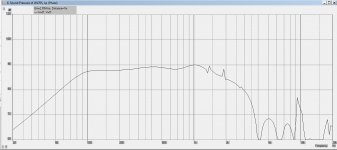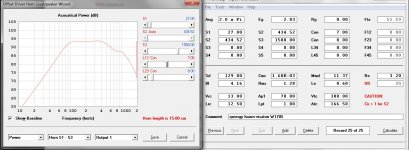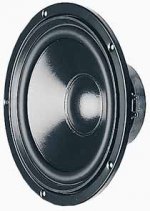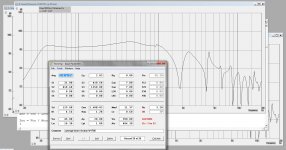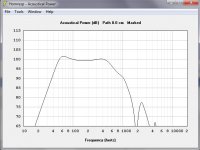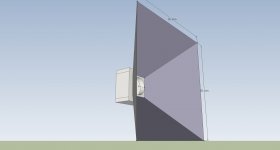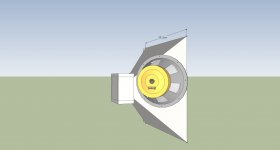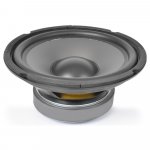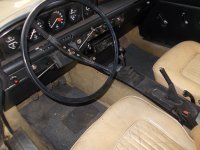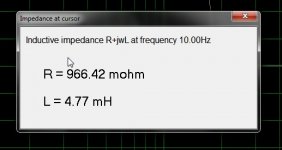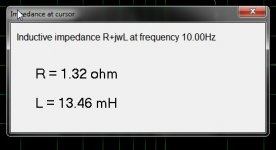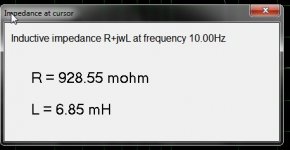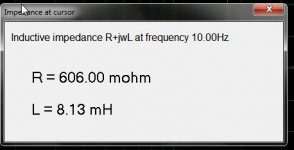Does HR predict off axis polar directivity?
The following directivity menu commands can be selected from the Acoustical Power window:
Tools > Directivity > Response
Tools > Directivity > Pattern
Tools > Directivity > Beam Width
Tools > Directivity > Polar Map
(Applicable to single-segment horns only)
The Legis Synergy horn system
You guys need to check out the progress that Legis has made on this system if you haven't already seen it.
http://www.diyaudio.com/forums/subwoofers/258706-study-dipole-cardioid-bass-horn-28.html#post4024054
You guys need to check out the progress that Legis has made on this system if you haven't already seen it.
http://www.diyaudio.com/forums/subwoofers/258706-study-dipole-cardioid-bass-horn-28.html#post4024054
An externally hosted image should be here but it was not working when we last tested it.
It is always interesting to test different speakers, this time thw W170S from visaton who is not expensive, but I do see that there is big difference between akabak and hornresp, to get hornresp sim oke I need to put the port very close to the throat, for akabak it sims oke when vtc is 300 cc and hornresp needs 700cc for a good sim.
I think hornresp can not do higher frequenties very good, hornresp is more a subwoofer simmer but it is very interesting when it do also frequenties to 20 Khz, but maybe this is not easy to implement.
I do also not now if akabak has trusted sims, I have learn it for 60 procent and I do use it for high frequentie sims.
regards
I think hornresp can not do higher frequenties very good, hornresp is more a subwoofer simmer but it is very interesting when it do also frequenties to 20 Khz, but maybe this is not easy to implement.
I do also not now if akabak has trusted sims, I have learn it for 60 procent and I do use it for high frequentie sims.
regards
Attachments
By the way, I need nod so low, I make a horn who go 70 a 80 hz to 20 Khz.
but way different outcomes betweet akabak and hornresp, help David
Attachments
Last edited:
Don't compare the acoustical pressure from akabak to the acoustical power from hornresp. Akabak can show you acoustic power also - its on a different screen/tab. You should be able to export an akabak script from a hornresp 2 pi simulation, change a couple of akabak parameters noted in the exported script and get the same response from both simulators.
Don't compare the acoustical pressure from akabak to the acoustical power from hornresp. Akabak can show you acoustic power also - its on a different screen/tab. You should be able to export an akabak script from a hornresp 2 pi simulation, change a couple of akabak parameters noted in the exported script and get the same response from both simulators.
Thanks
I go look at it, now I see, power or pressure.
regards
I think hornresp can not do higher frequenties very good,
Hi Kees,
Make sure that you are not confusing acoustical power response with acoustical pressure response
The on-axis pressure response extends to higher frequencies than the power response due to directivity effects causing "beaming" of the radiated energy.
Hornresp and AkAbak power response results will be identical if the two sets of input parameter values are the same. The pressure response results may differ at higher frequencies due to the different directivity models employed. AkAbak uses a relatively simple "radiation cone" method.
Both programs have the limitation that the driver diaphragm is considered to be a rigid plane piston at all frequencies, which is unlikely to be the case in practice.
Kind regards,
David
Thanks
I go look at it, now I see, power or pressure.
regards
I do not understand my sim go as high with a portdistance of 7 cm from throat, something has to be wrong with that or the speaker has weird specs.
Hot to measure the portdistance from throat? from center of horn to panel or just across the panels itselfs if I do explane it right.
Ohh the horn is to small for 8 inch woofer but a 6.5 inch fit well, like that visaton who also do good.
regards
Attachments
Last edited:
the picture you've drawn is a front loaded horn. Not an offset driver horn. Only when the driver is mounted on the side of the horn (on the flares) does the distance from the throat matter. In that case
1. draw a line on the axis of the horn,
2. draw a 2nd line perpendicular to the axial line to the center of the port hole for your driver.
3. The distance from the throat is measured from the apex of the horn to the intersection of the two lines.
After you create your simulation based on the geometry of the horn and this distance, add the acoustic path length of your CD to the L12 parameter (in the CON box on the 2nd row of the input parameters screen. This will give you a better prediction of where the acoustic null due to the reflection from the apex will occur. Values for several popular CDs, about 3 cm, can be found earlier in this thread.
1. draw a line on the axis of the horn,
2. draw a 2nd line perpendicular to the axial line to the center of the port hole for your driver.
3. The distance from the throat is measured from the apex of the horn to the intersection of the two lines.
After you create your simulation based on the geometry of the horn and this distance, add the acoustic path length of your CD to the L12 parameter (in the CON box on the 2nd row of the input parameters screen. This will give you a better prediction of where the acoustic null due to the reflection from the apex will occur. Values for several popular CDs, about 3 cm, can be found earlier in this thread.
the picture you've drawn is a front loaded horn. Not an offset driver horn. Only when the driver is mounted on the side of the horn (on the flares) does the distance from the throat matter. In that case
1. draw a line on the axis of the horn,
2. draw a 2nd line perpendicular to the axial line to the center of the port hole for your driver.
3. The distance from the throat is measured from the apex of the horn to the intersection of the two lines.
After you create your simulation based on the geometry of the horn and this distance, add the acoustic path length of your CD to the L12 parameter (in the CON box on the 2nd row of the input parameters screen. This will give you a better prediction of where the acoustic null due to the reflection from the apex will occur. Values for several popular CDs, about 3 cm, can be found earlier in this thread.
I have did a ND for the compression driver as seen, and a OD for the bas/mid speaker, but when I do also a OD for high driver I do not get much change. Do you sim
also front loaded horn for high and a offset horn for the bass/mid?
here a example drawn, I do need look, I have tryed in akabak to get the power sim like in hornresp but do not now how. I need two 6.5 inch woofers to fit this horn or make it bigger, but then respons get more bad.
Still with the ports such far from apex why I get respons to above 1000 hz?.
I did want to make 60, 90 horn but export this in hornresp make strange apex dimenson, (more a gap), yes I need some more playing with it.
regards
kees
Attachments
Last edited:
I have did a ND for the compression driver as seen, and a OD for the bas/mid speaker, but when I do also a OD for high driver I do not get much change. Do you sim
also front loaded horn for high and a offset horn for the bass/mid?
here a example drawn, I do need look, I have tryed in akabak to get the power sim like in hornresp but do not now how. I need two 6.5 inch woofers to fit this horn or make it bigger, but then respons get more bad.
OD will show response fairly high; you'll just see a notch in it at the frequency corresponding to 1/4 lambda from the apex (inside the HF driver). The mids will roll off due to the acoustic low pass filtering of the front chamber and port, if you model them.
Still with the ports such far from apex why I get respons to above 1000 hz?.
I did want to make 60, 90 horn but export this in hornresp make strange apex dimenson, (more a gap), yes I need some more playing with it.
regards
kees
yes sim the highs as FLH
I do know the tab is there, the problem is to find it. (timeout to open akabak which is a pain on my 64-bit machine and figure it out again) Look on the top row tool bar. Click on "sum". Acoustic power and acoustic pressure are the first two options
Last edited:
Not sure if some of you may have seen this thread. Sometimes things work without any sims. Rarely though.
The very low budget DIY synergy horn build - Page 2 - AVS Forum
I do know that AkAbak models a side injection port pretty accurately though for a Synergy. Here are predicted vs measured impedances for Legis' monster Synergy with dual Deltalite 15 mid drivers.
http://www.diyaudio.com/forums/subwoofers/258706-study-dipole-cardioid-bass-horn-29.html
The very low budget DIY synergy horn build - Page 2 - AVS Forum
I do know that AkAbak models a side injection port pretty accurately though for a Synergy. Here are predicted vs measured impedances for Legis' monster Synergy with dual Deltalite 15 mid drivers.
http://www.diyaudio.com/forums/subwoofers/258706-study-dipole-cardioid-bass-horn-29.html
I did see in hornresp that under tools there is a xhamber type, when I do lined then it do not go to 1Khz anymore, when choose ported it do go to 1 to 1.2 Khz.
little confusion.
NC535 I go look at akabak where it is, but in hornresp there is also this possebility to put it acoustical i did read somewhere
I have found it and try it, and yes then it predict like hornresp.
regards
little confusion.
NC535 I go look at akabak where it is, but in hornresp there is also this possebility to put it acoustical i did read somewhere
I have found it and try it, and yes then it predict like hornresp.
regards
Last edited:
when you choose "throat ported" in chamber type under tools, then you are modeling the volume of air trapped between the cone and the wall of the horn and the port through that wall into the horn. This acts like a low pass filter. The following four paramters then become important and will determine the high frequency response: Ap, Vtc, Lpt, Atc. Definitions are in the help file. You play play with them using Loudspeaker Wizard.
Hope that helps
Hope that helps
when you choose "throat ported" in chamber type under tools, then you are modeling the volume of air trapped between the cone and the wall of the horn and the port through that wall into the horn. This acts like a low pass filter. The following four paramters then become important and will determine the high frequency response: Ap, Vtc, Lpt, Atc. Definitions are in the help file. You play play with them using Loudspeaker Wizard.
Hope that helps
thanks, now I understand, yes some drivers in the synergy who has to do low end needs sometimes that ported throat as extra for the early fall off.
I did discover that drivers with a qts of 0.40 to 0.60 do well for the low end like skytech who costs 19 to 35 euro.
I did see Danley has 2 way systems who go to even 55 hz, with a compression driver who needs above 1 Khz crossover. so much to do, but it is fun that is what I can tell. Now the real world, first making a machine who can mill angles. And of course making my Rover P6 running.
regards
Attachments
Last edited:
Little out of topic but I did measure with limp some speakers, but no succes, jig is oke, I use headphone output on pc intern audio.
just every measurement differend outcome, I did a coil measure, coil is 6.8 mH, just one measurement was right, I did also measure a reference speaker, way out of specs, I can not trust that for making a synergy..
.
just every measurement differend outcome, I did a coil measure, coil is 6.8 mH, just one measurement was right, I did also measure a reference speaker, way out of specs, I can not trust that for making a synergy..
.
Attachments
Last edited:
You will never reach 15KHz when horn loading the PRV mid. You will start to see the high frequencies dropping off starting at around 1400Hz. Even with the narrowing directivity of the tractrix you will not get anything useful past about 5KHz. Not even a phasing plug will get you to 15KHz.
The Tractrix indeed reaches 15kHz and is anything but narrow directivity. I still need to optimize the EQ and rear chamber but initial tests appear very promising for the 5MR450NDY driver in a FLH. There is a 10dB drop near 1400 Hz as you say but I believe this corresponds to a rear chamber reflection cancellation combined with a -5dB BSC sheld at 1100Hz from the previous setup's EQ which hasn't been removed yet.
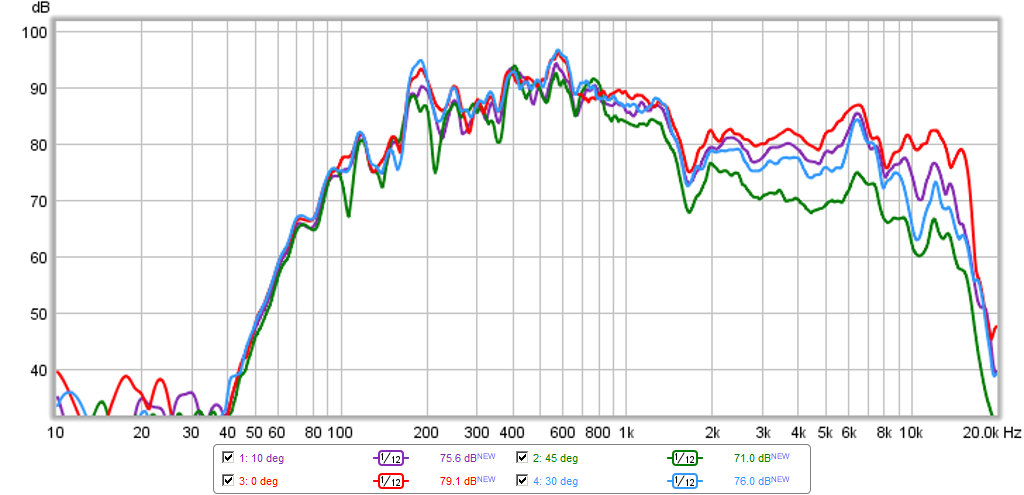
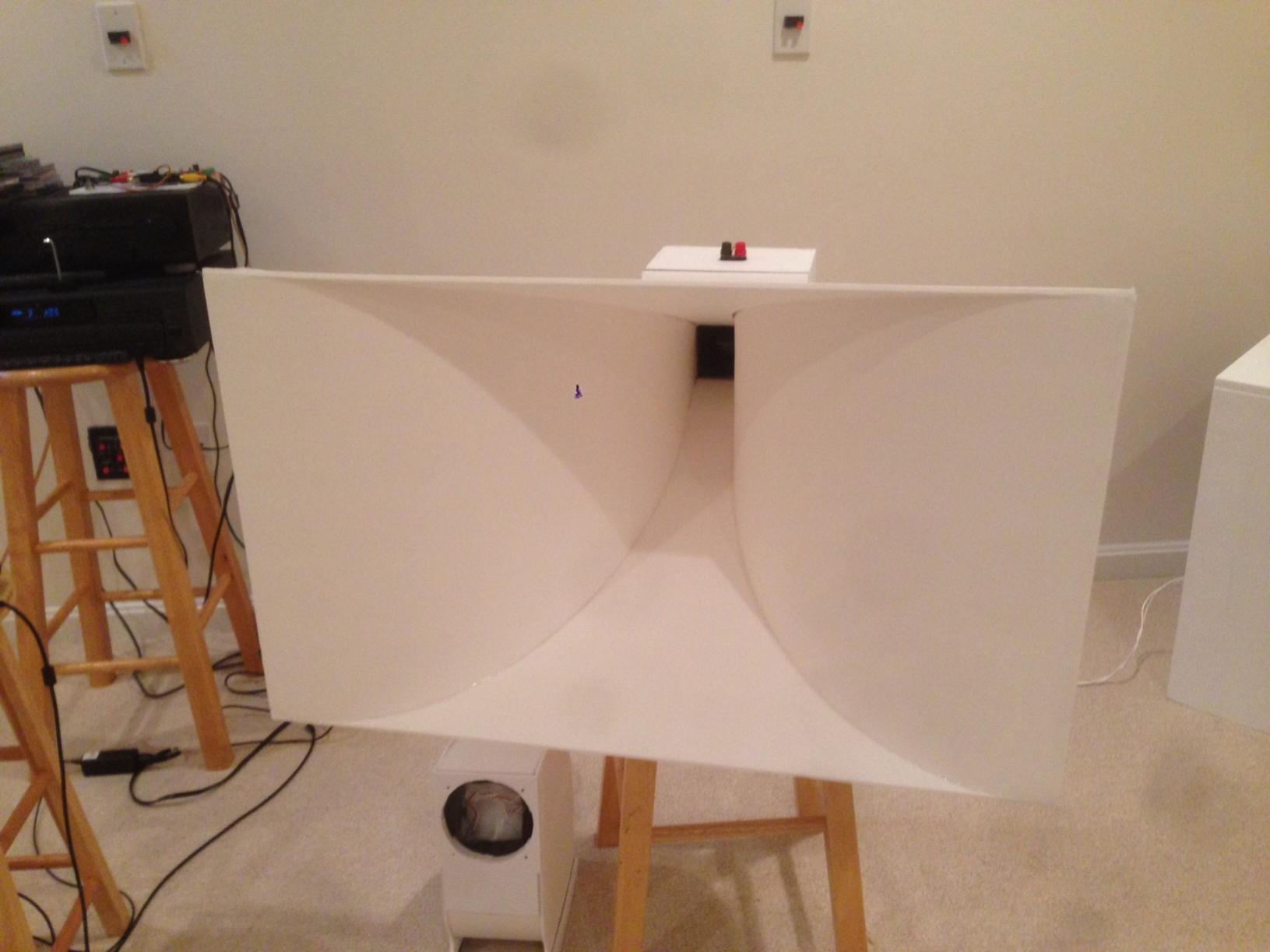
More info here:
http://www.diyaudio.com/forums/full-range/259293-prv-5mr450-ndy-fast-applications-10.html#post4034668
Last edited:
xrk971,
What you think you have there and what it really is, is two different things. I guess that makes me one of the "naysayers". Do you find it even remotely interesting that I predicted the drop off at 1400Hz? Do you know how I was able to predict that even before you built your horn? It's because I've been building horns for a very long time and know how they work. All the response above 1400Hz is a combination of cone break up and horn resonance. Everything above 1400Hz is not usable bandwidth and does not qualify as good fidelity. If you believe you're actually getting usable response out to 15KHz then I can only surmise you also believe Klipsch, Keele, Leach, Salmon, Edgar, Olson and Cohen are all idiots. All your claims fly in the face of what has been established as fact for a very long time.
What you think you have there and what it really is, is two different things. I guess that makes me one of the "naysayers". Do you find it even remotely interesting that I predicted the drop off at 1400Hz? Do you know how I was able to predict that even before you built your horn? It's because I've been building horns for a very long time and know how they work. All the response above 1400Hz is a combination of cone break up and horn resonance. Everything above 1400Hz is not usable bandwidth and does not qualify as good fidelity. If you believe you're actually getting usable response out to 15KHz then I can only surmise you also believe Klipsch, Keele, Leach, Salmon, Edgar, Olson and Cohen are all idiots. All your claims fly in the face of what has been established as fact for a very long time.
JLH,
I know you are an expert on horns and have studied your designs and many postings on Synergies, etc. I do respect your deep knowledge but let's not put words in my mouth. I never said anything about all the greats of audio design to be idiots. What would you say is a quantifiable measurement of the usable bandwidth above 1400 Hz as having good fidelity? Flat response? Harmonic distortion? Impulse Response? All of these? Anything else?
For a 5 in paper cone driver, it achieves the higher frequencies via cone breakup, that is a given, yet it still sounds good, open faced, outside of a horn. A horn will have resonances, but according to the sims of a tractrix, the resonances are small - that is why the profile is a tractrix. So I am not sure why you say all the output above 1400 Hz is bad just because it is made of cone breakup, and horn resonances (which I believe are small for this particular profile).
I know you are an expert on horns and have studied your designs and many postings on Synergies, etc. I do respect your deep knowledge but let's not put words in my mouth. I never said anything about all the greats of audio design to be idiots. What would you say is a quantifiable measurement of the usable bandwidth above 1400 Hz as having good fidelity? Flat response? Harmonic distortion? Impulse Response? All of these? Anything else?
For a 5 in paper cone driver, it achieves the higher frequencies via cone breakup, that is a given, yet it still sounds good, open faced, outside of a horn. A horn will have resonances, but according to the sims of a tractrix, the resonances are small - that is why the profile is a tractrix. So I am not sure why you say all the output above 1400 Hz is bad just because it is made of cone breakup, and horn resonances (which I believe are small for this particular profile).
- Home
- Loudspeakers
- Multi-Way
- Suitable midrange cone, for bandpass mid in Unity horn.
